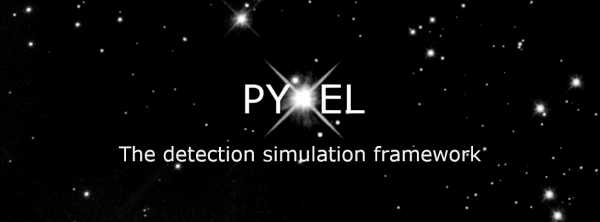Pyxel - A software framework for imaging detector simulation
 |
Pyxel is a novel, end-to-end detection chain simulation framework in Python for imaging detectors, designed to host and combine existing and new models, i.e. codes simulating instrument effects such as optical diffraction, charge deposition by cosmic rays, charge diffusion, detector Point Spread Function, readout noise sources, Charge Transfer Inefficiency in CCD or persistence in CMOS-based imaging detectors.
This general, collaborative simulation framework has been developed in order to avoid re-developing and re-implementing simulation codes, models & tools for every new instrument on-board space missions or ground observatories, but instead to run and share simulation codes via the Pyxel framework. Therefore new simulation codes can be added easily and quickly by the users.
Pyxel is an easy-to-use, easy-to-contribute and multi-purpose tool supporting instrument development during all phases, for example to generate synthetic data, support data processing and analysis, estimate performance, investigate problem sources or trade between different technologies.
By running Pyxel, users can perform a parameter sensitivity analysis, fit models to target data using optimization (e.g. evolutionary) algorithms in order to calibrate model or optimize instrument parameters, as well as simulate time-dependent, non-destructive readout for a CMOS image sensor. The output of the framework includes images with the simulated detector effects combined, plots, and evolution of parameters.
Pyxel is developed at the European Space Agency in collaboration with the European Southern Observatory (ESO), and will be released soon as a fully open-source software. Our goal is to establish a worldwide collaboration based on Pyxel to share simulation resources, initiate and facilitate the knowledge transfer within the instrumentation community of Space Astronomy, Ground-based Astronomy and Earth observation.
More information
Pyxel website: https://esa.gitlab.io/pyxel
Email: pyxel![]() esa.int
esa.int
Reference publication:
David Lucsanyi, Thibaut Prod'homme, Hans Smit, Frederic Lemmel, Pierre-Elie Crouzet, Peter Verhoeve, and Brian Shortt, "Pyxel: a novel and multi-purpose Python-based framework for imaging detector simulation", SPIE Proceedings Volume 10709, High Energy, Optical, and Infrared Detectors for Astronomy VIII; 107091A (2018), https://doi.org/10.1117/12.2314047

